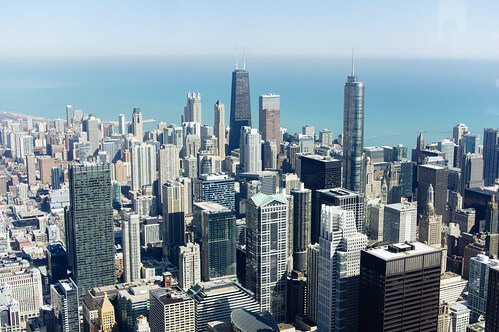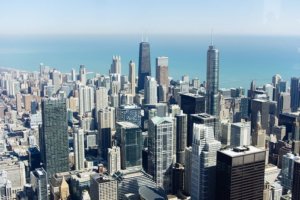
Chicago goes by many names. Depending on which part of the country you’re from, you may know one or more of these nicknames. It’s known as the Windy City, Mud City, Chi-Town, City by the Lake, Heart of America, The 312, or The City Beautiful. Chicago has been referenced by several names and for a variety of reasons. One nickname that Chicago is also well known for is the Second City.
Why Is Chicago Called the Second City?

Image via Flickr by Conal Gallagher
Chicago has been called the Second City for a few reasons. Depending on which research book you pick up or who you talk to, you may get a different answer for how Chicago earned the nickname the Second City. Here are a few theories on how Chicago came to be known as the Second City:
Rebuilding a Second Time
In 1871 the City of Chicago suffered a horrific fire where the entire town was burned to ash. At this given moment in time, Chicagoans could have given up and relocated to a new location. Instead, the people of Chicago decided to work together to rebuild this beautiful city. They planned to make Chicago bigger and better, and because the people wanted to give Chicago a second chance, it became known as the Second City. In Mayer’s and Wade’s book, The Growth of a Metropolis, they entitled a chapter “The Second City” that addresses this theory.
Second in Size
Chicago was a developing city, centrally located in the United States, and many people started congregating there. It became a booming city with people and businesses. It seemed as if Chicago was competing with New York City. Which city could attract more people? New York had the benefit of being a harbor city. As new people began immigrating to the country, they often landed here. To get to Chicago, you would have to travel, and no matter how hard Chicago tried, they just couldn’t keep up with New York.
Jane Adams thought up one way to try to get people to move to Chicago, even if it involved traveling inland. Adams opened up a Hull House, a settlement house for immigrants, to learn English and new skills. Immigrants came from Greece, Russia, Ireland, Poland, Scandinavia, and Italy to try to make it in the New World.
This fantastic idea of Adams’ has blossomed into The Erie Neighborhood House that is still in existence. The Erie Neighborhood now welcomes largely Hispanic people. It has been a powerful way to get new people to make Chicago home. However, Chicago still could not compete with New York. Because of that, it was said that Chicago became known as The Second City behind New York.
Chicago has put up a valiant effort to be the biggest city in the United States. There are many reasons to want to reside in Chicago, from the shops to the potential job opportunities. Even though Chicago has a lot to offer, this city is no longer in second place population-wise. It has slowly fallen behind Los Angeles, so even the nickname The Second City would not apply any longer for this speculation.
Second-Rate
In 1952, A.J Liebling published a book titled “Chicago: The Second City.” Liebling was a former New Yorker who despised Chicago. He was not impressed with the nightlife nor the city life that Chicago had to offer. Disappointed by the restaurants, parks, culture, and theatre, Liebling was higher aggravated by his Chicago experience and chose to express that in writing.
In addition to the lack of offerings, Liebling was also unimpressed by Chicago’s outright corruption and mob ties. Robert Merriam was an alderman who boasted about being honest, yet blatantly stated to Liebling that Chicago was unique because it was completely corrupt and the only one of its kind in America. Merriam would boast about bribery in the same breath that he would complain about it. Liebling saw Chicago as a second-rate city, thus giving it the name The Second City, and wrote about it as such.
Chicago Rises Up
In the early 1960s, Chicago was on track to make a comeback. They invested a billion dollars in giving the downtown a new facelift. Chicago didn’t want to be a second-class city any longer. They altered the skyline with huge skyscrapers and added parks and theatres to bring in people who loved showcasing their talents and spectators who wanted to be amazed by their work. Planners looked for ways to attract artists and music lovers, building programs and places to support expansion in these areas.
In 1959, Chicago opened up a comedy troupe where comedians came from all over to put on a comedy show. From Bill Murray and John Belushi to Tina Fey, many people came to see these talented comedians. Chicago eventually named this comedy troupe The Second City comedy troupe, and this is where Saturday Night Live has recruited many of its comedians. Saturday Night Live (SNL) soon became a late-night phenomenon highlighting up-and-coming comedians, actors, and music acts as well as showcasing well-known and established acts. SNL has been on the air since 1975, one of the longest-running shows on television.
Despite the steep measures taken to increase the population of Chicago, the city still cannot compete with New York or Los Angeles and is actually losing ground. Chicago gave up on the title of the second-largest city in the United States years ago and is now looking at losing its title as third-largest. The city of Houston is creeping up on the horizon, looking to put Chicago in fourth place.
Chicago still has so much to offer. After rebuilding from the devastating fire in 1871, Chicago is a place one could easily call home. It’s a great place to find a good-paying career, explore your art and music talents, or enjoy the nightlife. Chicago offers amazing museums, centers of higher learning, shopping centers, and more. Its rich heritage and history make Chicago a unique place to live with pride. Don’t let some disgruntled New Yorker steer you in the wrong direction. Chicago, The Second City, will not disappoint.
If you’re interested in checking out another thing that Chicago is famous for, Chicago-style pizza, then pop into Pequod’s Pizza on Clybourn Avenue. You’ll find Chicago’s best deep-dish pizza and one more reason to love Chicago.